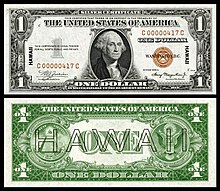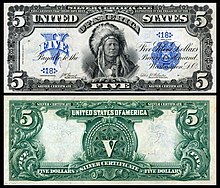Silver certificate (United States)
Silver certificates are a type of representative money issued between 1878 and 1964 in the United States as part of its circulation of paper currency.
[1] They were produced in response to silver agitation by citizens who were angered by the Fourth Coinage Act, which had effectively placed the United States on a gold standard.
[1] Since 1968 they have been redeemable only in Federal Reserve Notes and are thus obsolete, but still valid legal tender at their face value and thus are still an accepted form of currency.
[15] By 1875 business interests invested in silver (e.g., Western banks, mining companies) wanted the bimetallic standard restored.
[19] Some blamed the passage of the Act on a number of external factors including a conspiracy involving foreign investors and government conspirators.
[26] The Bland–Allison Act established that they were "receivable for customs, taxes, and all public dues,"[20] and could be included in bank reserves,[22] but silver certificates were not explicitly considered legal tender for private interactions (i.e., between individuals).
[31] Treasury Secretary Franklin MacVeagh (1909–13) appointed a committee to investigate possible advantages (e.g., reduced cost, increased production speed) to issuing smaller sized United States banknotes.
On August 20, 1925, Treasury Secretary Andrew W. Mellon appointed a similar committee and in May 1927 accepted their recommendations for the size reduction and redesign of U.S.
People called the note the Funnyback based on the dramatically lighter green ink used on the reverse and unusually large font which was used for the word "ONE" in the center of the design.
One notable exception was the Series 1935G $1 silver certificate, which included notes both with and without the motto "In God We Trust" on the reverse.
[37] In response to the Japanese attack on Pearl Harbor, the Hawaii overprint note was ordered from the Bureau of Engraving and Printing on June 8, 1942 (all were made-over 1934–1935 bills).
[39] Additional World War II emergency currency was issued in November 1942 for circulation in Europe and Northern Africa.
[33] Printed with a bright yellow seal, these notes ($1, $5, and $10) could be demonetized should the United States lose its position in the European or North African campaigns.


